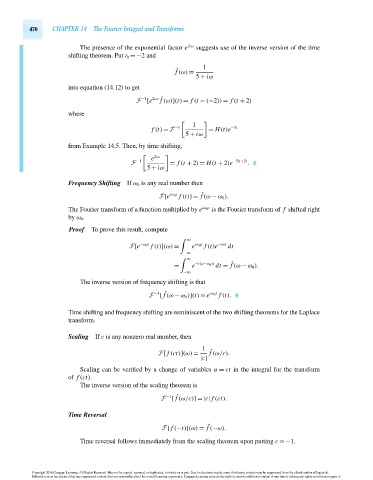Page 496 - Advanced engineering mathematics
P. 496
476 CHAPTER 14 The Fourier Integral and Transforms
The presence of the exponential factor e 2iω suggests use of the inverse version of the time
shifting theorem. Put t 0 =−2 and
1
ˆ
f (ω) =
5 + iω
into equation (14.12) to get
−1
F [e 2iω f (ω)](t) = f (t − (−2)) = f (t + 2)
ˆ
where
1
−1 −5t
f (t) = F = H(t)e
5 + iω
from Example 14.5. Then, by time shifting,
e
2iω
−1 −5(t+2)
F = f (t + 2) = H(t + 2)e .
5 + iω
Frequency Shifting If ω 0 is any real number then
ˆ
F[e iω 0 t f (t)]= f (ω − ω 0 ).
The Fourier transform of a function multiplied by e iω 0 t is the Fourier transform of f shifted right
by ω 0 .
Proof To prove this result, compute
∞
F[e −ω 0 t f (t)](ω) = e iω 0 t f (t)e −iωt dt
−∞
∞
ˆ
= e −i(ω−ω 0 )t dt = f (ω − ω 0 ).
−∞
The inverse version of frequency shifting is that
−1
F [ f (ω − ω 0 )](t) = e iω 0 t f (t).
ˆ
Time shifting and frequency shifting are reminiscent of the two shifting theorems for the Laplace
transform.
Scaling If c is any nonzero real number, then
1
ˆ
F[ f (ct)](ω) = f (ω/c).
|c|
Scaling can be verified by a change of variables u = ct in the integral for the transform
of f (ct).
The inverse version of the scaling theorem is
−1
F [ f (ω/c)]=|c| f (ct).
ˆ
Time Reversal
ˆ
F[ f (−t)](ω) = f (−ω).
Time reversal follows immediately from the scaling theorem upon putting c =−1.
Copyright 2010 Cengage Learning. All Rights Reserved. May not be copied, scanned, or duplicated, in whole or in part. Due to electronic rights, some third party content may be suppressed from the eBook and/or eChapter(s).
Editorial review has deemed that any suppressed content does not materially affect the overall learning experience. Cengage Learning reserves the right to remove additional content at any time if subsequent rights restrictions require it.
October 14, 2010 16:43 THM/NEIL Page-476 27410_14_ch14_p465-504

